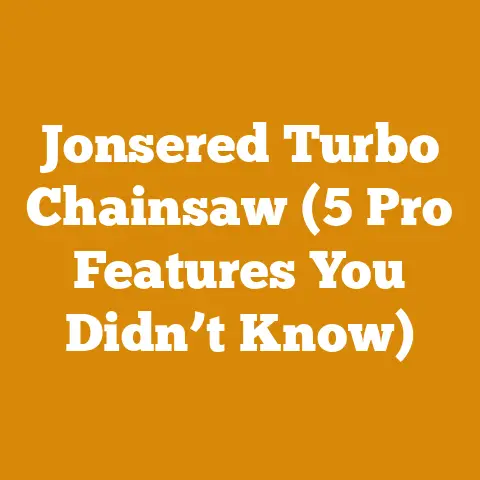Stihl Chainsaw Chain Prices vs Value (Expert Arborist Insights)
The air hangs thick with the scent of pine and sawdust, a symphony of woodsy aromas that always signals a productive day. I’m standing here, boots dusted with wood shavings, ready to dive into a topic that’s near and dear to any serious woodcutter’s heart: Stihl chainsaw chains. More specifically, the age-old question of Stihl chainsaw chain prices versus value. As a seasoned arborist, I’ve spent years wrestling with this very dilemma, and I’m here to share my hard-earned insights, cutting through the marketing fluff to give you the real wood.
Stihl Chainsaw Chain Prices vs Value: Expert Arborist Insights
Choosing the right chainsaw chain is more than just picking the cheapest option. It’s about balancing cost with performance, durability, and safety. A cheap chain might save you a few bucks upfront, but if it dulls quickly, stretches excessively, or, worse, breaks mid-cut, you’ll end up spending more time and money in the long run. Plus, a dull or unreliable chain significantly increases the risk of kickback and other chainsaw-related injuries.
The Stihl Advantage: What You’re Paying For
Stihl has built its reputation on quality, reliability, and innovation. When you buy a Stihl chainsaw chain, you’re not just buying a piece of metal; you’re investing in decades of engineering and manufacturing expertise. Here’s what sets Stihl chains apart:
- Steel Quality: Stihl uses high-grade steel alloys that are specifically formulated for chainsaw applications. This translates to better wear resistance, longer sharpness, and increased durability. I’ve personally found that Stihl chains hold their edge longer than many aftermarket brands, even when cutting through hardwoods like oak and maple.
- Precision Manufacturing: Stihl chains are manufactured to incredibly tight tolerances, ensuring consistent performance and smooth cutting. This precision also reduces vibration, making the saw easier to handle and reducing operator fatigue.
- Hard Chroming: Stihl’s hard chroming process enhances the chain’s resistance to wear and corrosion. This is especially important if you frequently cut in wet or dirty conditions. I’ve seen firsthand how this chroming extends the life of the chain, even when working in abrasive environments.
- Pre-Stretching: Many Stihl chains are pre-stretched at the factory, which minimizes stretching during initial use. This means less downtime for adjustments and a more consistent cutting experience.
- Safety Features: Stihl incorporates safety features like bumper drive links and depth gauge designs that help reduce kickback. While no chain is entirely kickback-proof, these features can significantly improve safety, especially for less experienced users.
Understanding Stihl Chain Codes: Decoding the Mystery
Stihl uses a coding system to identify different chain types. Understanding these codes is crucial for selecting the right chain for your needs. Here’s a breakdown of some common Stihl chain codes:
- Rapid Micro (RM): These are general-purpose chains that offer a good balance of cutting speed and smoothness. They are a popular choice for homeowners and occasional users. I often recommend RM chains for cutting firewood because they are forgiving and easy to sharpen.
- Rapid Super (RS): These chains are designed for professional use and offer maximum cutting speed and efficiency. They are ideal for felling large trees and cutting dense hardwoods. I use RS chains when I need to get a job done quickly and efficiently.
- Rapid Duro (RD): These chains feature carbide-tipped cutters that are extremely resistant to wear. They are designed for cutting abrasive materials like dirty wood, roots, and even some types of stone. RD chains are a lifesaver when working in challenging conditions where a standard chain would dull quickly.
- Picco Micro (PM): These are low-vibration chains designed for smaller chainsaws. They are a good choice for pruning and light-duty cutting tasks. I use PM chains on my smaller saws for limbing and pruning branches.
- Picco Duro (PD): Similar to RD chains, but designed for smaller saws. They also feature carbide-tipped cutters for extended durability.
Stihl Chainsaw Chain Prices: A Deep Dive
Now, let’s get down to the nitty-gritty: prices. Stihl chainsaw chain prices vary depending on the chain type, length, and gauge. Here’s a general overview of what you can expect to pay:
| Chain Type | Typical Price Range (16-inch) | Notes |
|---|---|---|
| Rapid Micro (RM) | $25 – $35 | Good all-around chain, suitable for most users. |
| Rapid Super (RS) | $30 – $45 | High-performance chain for professional use. |
| Rapid Duro (RD) | $60 – $90 | Carbide-tipped chain for abrasive conditions. |
| Picco Micro (PM) | $20 – $30 | Low-vibration chain for smaller saws. |
| Picco Duro (PD) | $50 – $70 | Carbide-tipped chain for smaller saws in abrasive conditions. |
These prices are approximate and may vary depending on your location and the retailer. Always check with your local Stihl dealer for the most accurate pricing.
The Value Proposition: Is Stihl Worth the Investment?
The higher price of Stihl chains often raises the question: are they really worth the investment? In my experience, the answer is a resounding yes, but it depends on your specific needs and usage patterns.
Here’s a breakdown of the value proposition:
- Longevity: Stihl chains typically last longer than cheaper alternatives. The higher-quality steel and hard chroming process contribute to increased wear resistance. I’ve found that a well-maintained Stihl chain can last twice as long as a cheaper chain, even with regular use.
- Performance: Stihl chains cut faster and more smoothly than many other brands. This translates to increased productivity and reduced operator fatigue. When I’m felling trees all day, the difference in performance is noticeable and makes a big difference in my overall efficiency.
- Safety: Stihl’s safety features, such as bumper drive links and depth gauge designs, can help reduce the risk of kickback. This is especially important for less experienced users. I always prioritize safety, and I appreciate the extra layer of protection that Stihl chains provide.
- Reduced Downtime: Because Stihl chains hold their edge longer and are less prone to stretching, you’ll spend less time sharpening and adjusting your chain. This means more time cutting wood and less time fiddling with your saw.
- Cost-Effectiveness: While Stihl chains may cost more upfront, their longer lifespan and improved performance can actually make them more cost-effective in the long run. Consider the cost of replacing a cheaper chain more frequently, plus the added downtime for sharpening and adjustments.
When to Splurge and When to Save: Making the Right Choice
Not every woodcutter needs the top-of-the-line Stihl chain. Here’s a guide to help you decide when to splurge and when to save:
- Splurge When:
- You use your chainsaw frequently (e.g., daily or weekly).
- You cut dense hardwoods or abrasive materials.
- Safety is a top priority.
- You value performance and efficiency.
- You want to minimize downtime.
- Save When:
- You use your chainsaw infrequently (e.g., a few times a year).
- You only cut softwoods or small branches.
- You are on a tight budget.
- You are willing to accept lower performance and more frequent sharpening.
Real-World Examples: Stihl Chains in Action
To illustrate the value of Stihl chains, let me share a few real-world examples from my own experience:
- Case Study 1: Clearing a Storm-Damaged Forest: After a major storm, I was contracted to clear a heavily damaged forest. The job involved cutting through a mix of hardwoods and softwoods, many of which were covered in dirt and debris. I used a Stihl MS 462 with an RS chain for the majority of the work. The chain held its edge remarkably well, even when cutting through dirty wood. I only had to sharpen it once a day, which was a huge time-saver.
- Case Study 2: Cutting Firewood: I regularly cut firewood to heat my home. I typically use a Stihl MS 271 with an RM chain. This combination provides a good balance of power and efficiency for cutting firewood. The RM chain is easy to sharpen and holds its edge well enough for several cords of wood.
- Case Study 3: Removing a Large Oak Tree: I was hired to remove a large oak tree that was threatening a house. The tree was old and dense, and the wood was extremely hard. I used a Stihl MS 661 with an RD chain for this job. The carbide-tipped chain was essential for cutting through the tough oak wood without dulling quickly.
Maximizing Chain Life: Maintenance Matters
No matter how good your chainsaw chain is, proper maintenance is essential for maximizing its lifespan and performance. Here are some tips for keeping your chain in top condition:
- Sharpen Regularly: A sharp chain is a safe chain. Sharpen your chain whenever it starts to feel dull or when you notice it’s producing fine sawdust instead of chips. I recommend using a Stihl filing kit for consistent and accurate sharpening.
- Maintain Proper Chain Tension: Proper chain tension is crucial for preventing premature wear and reducing the risk of kickback. Check the chain tension before each use and adjust as needed. The chain should be snug against the bar but still able to be pulled around by hand.
- Lubricate Regularly: Use a high-quality bar and chain oil to keep your chain properly lubricated. This will reduce friction and wear, extending the life of your chain. I prefer Stihl bar and chain oil because it’s specifically formulated for their chainsaws.
- Clean Regularly: Keep your chain clean by removing sawdust and debris after each use. This will prevent the buildup of dirt and grime, which can accelerate wear.
- Store Properly: Store your chainsaw in a dry place with the chain guard in place. This will protect the chain from rust and damage.
Beyond Stihl: Exploring Alternative Options
While I’m a big fan of Stihl chains, there are other reputable brands on the market. Oregon is a well-known manufacturer of chainsaw chains, and their chains are often more affordable than Stihl. However, in my experience, Oregon chains don’t hold their edge as long as Stihl chains.
The Bottom Line: Making an Informed Decision
Choosing the right chainsaw chain is a balancing act between price and value. While Stihl chains may cost more upfront, their superior quality, performance, and safety features often make them a more cost-effective choice in the long run. However, if you only use your chainsaw occasionally or are on a tight budget, a cheaper chain may be sufficient.
Ultimately, the best chainsaw chain for you depends on your specific needs and usage patterns. Consider the type of wood you’ll be cutting, the frequency of use, and your budget when making your decision. And remember, proper maintenance is essential for maximizing the lifespan of any chainsaw chain.
Don’t skimp on the chain; it’s the part of the saw that actually does the cutting, and it’s worth spending a little extra to get a good one.






